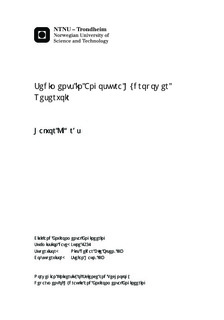Sediments in Angostura Hydropower Reservoir
Master thesis
Permanent lenke
http://hdl.handle.net/11250/242306Utgivelsesdato
2012Metadata
Vis full innførselSamlinger
Sammendrag
Reservoirs in areas with a high sediment yield will without mitigation sooner or later be filled up with sediments, reducing the volume available for regulation for electric generation. Flushing of sediments is a management strategy used in many reservoirs in the world, with varying degree of success. The Angostura reservoir is a shallow reservoir located on an inundated river, making it extra vulnerable to sedimentation. It is estimated a yearly inflow of 1.5 million tons of sediment. Other reservoirs are located upstream, and the flushing of these leads to large quantities of sediment inflow in a short period of time. In September every year, the water level in Angostura is partially drawn down to route this sediment through the reservoir. In November, the water level is drawn down completely, and a full sediment flushing is performed. The RESCON model is a spreadsheet program designed to find a technically feasible sediment management strategy that maximizes the economical benefits of the project. Flushing is modeled with a simple algebraic model. SSIIM is a three-dimensional computational fluid dynamics program designed for hydraulic engineering. Sediment erosion, transport and sedimentation can be modeled in a complex reservoir geometry using an adaptive grid with a moveable bed. The main objective of this thesis is to test the performance of the RESCON and SSIIM models. The RESCON model was tested on the November flushing to see if it can reproduce the measured volume of flushed sediments. SSIIM was used for simulation of sediment concentration distribution in the reservoir, and to model the September flushing. The results are compared to measured values. The reservoir geometry is based on bathymetry data from September 2011. Inflow series are from logged values at the hydropower plant. Depth-averaged concentration values are used to present the longitudinal concentration distribution, and Hunter Rouse profiles to present the vertical distribution. Using known reservoir values and the recommended coefficients, the RESCON model was not able to get close to the actual volume of flushed sediments. Although the model has given promising results in other cases, the complex reservoir geometry in Angostura sets heavy restrictions on the flushing processes in the reservoir, which an algebraic model of this type cannot reproduce. The steady state simulation was successful in explaining previously unexplained variations in the concentration in the lateral and longitudinal direction of the reservoir. The simulation reproduces the longitudinal and vertical concentration distribution well. A bug in the implementation of the second-order scheme in SSIIM was discovered, which has later been fixed, giving more similar results for the first-order and second-order schemes. The time allocated for the flushing simulation was not enough to get satisfactory results. The erosion in the upstream end is modelled well, but the measured sedimentation in the downstream area is much larger than in the simulations. With more time for this simulation, it would have been possible to increase the quality of the results.
